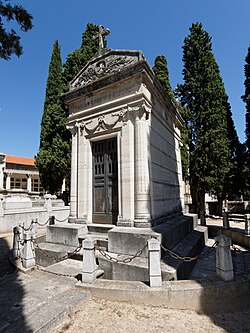Saint Isidore Cemetery
| Saint Isidore Cemetery | |
|---|---|
Cementerio de San Isidro | |
 | |
| Alternative names | Pontifical and Royal Sacramental Arch-confraternity of St Peter, St Andrew, St Isidore and of the Immaculate Conception |
| Etymology | Saint Isidore the Farmer |
| General information | |
| Status | Active cemetery |
| Type | Cemetery |
| Architectural style | Various |
| Address | Calle Ermita del Santo 78 |
| Town or city | Madrid |
| Country | Spain |
| Coordinates | 40°24′03″N 3°43′40″W / 40.40083°N 3.72778°W |
| Construction started | 1811 |
| Inaugurated | 1811 |
| Owner | Archicofradía Sacramental de San Pedro San Andrés y San Isidro |
| Affiliation | Catholic Church |
| Technical details | |
| Floor area | 120,000 m2 (1,300,000 sq ft) |
| Design and construction | |
| Architect(s) | José Llorente |
| Website | |
| www | |
Saint Isidore Cemetery is a
History

The
The first burial was performed in 1811.
Throughout the 19th century, St Isidore became the cemetery of Madrid's nobility. It became the final resting place of choice for aristocrats, bourgeoisie, politicians and artists. For this reason its seven courtyards boast a multitude of
Characteristics

It is located in the Carabanchel district of Madrid, behind the hermitage of St Isidore on the so-called "hill of souls" (cerro de ánimas)[5] near Via Carpetana street and bordered on one side by Ermita del Santo avenue.
The three oldest of the seven courtyards that comprise the cemetery are of rectangular shape and cloistered structure and contain the niches, giving them the most sober appearance. The oldest courtyard is that of St Peter, built in 1811 by the architect José Llorente.
Notable burials
- Leandro Fernández de Moratín (1760–1828), Spanish playwright and poet.
- Marquess of San Isidro (1806–1885), Spanish noble, politician and army officer.
- Conde de Campomanes (1723–1802), Spanish politician.
- Ángel de Saavedra y Ramírez de Baquedano, Duque de Rivas, (1791–1865) Spanish poet, dramatist and politician.
- Diego de León (1807–1841), Count Belascoaín.
- Manuel Montes de Oca (1804–1841), Spanish naval commander and politician.
- Francisco Javier de Istúriz[9] (1790–1871), Spanish President.
- Ramón de Mesonero Romanos (1803–1882), Spanish author.
- Frances Mary ("Fanny") Keats (1803–1889), the younger sister of John Keats.
- José de Salamanca y Mayol(1811–1883), Spanish politician and financier, Marquis of Salamanca.
- Emilio Castelar[10] (1832–1899), Spanish politician, historian, journalist and writer. President of the Executive during the First Spanish Republic.
- Francisco Silvela[11] (1843–1905), Spanish politician.
- Segismundo Moret[12] (1833–1913), Spanish politician and writer.
- Fernando Primo de Rivera y Orbaneja[13] (1879–1921), Spanish politician and soldier.
- Consuelo Vello Cano «La Fornarina» (1885–1915), Spanish cupletista.
- José Echegaray (1832–1916), Spanish politician, playwright and mathematician.
- Leonardo Torres Quevedo[14] (1852–1936), Spanish engineer, mathematician and inventor.
- Antonio Maura[15] (1853–1925), Spanish politician and president of the council of ministers.
- Miguel Primo de Rivera[16] (1870–1930), Spanish aristocrat and military officer, Prime Minister of Spain 1923–1930. His remains were later moved to the Basílica de la Merced in Jerez de la Frontera.[17]
- Felipe de Lazcano y Morales de Setién (1868–1951), lawyer, businessman, politician and financier.
- Ante Pavelić (1889–1959), Croatian dictator and leader of the Ustaše.
- Fulgencio Batista (1901–1973), Cuban soldier, politician and dictator.
- Miguel Boyer (1939–2014), Spanish economist, academic and former minister.
- Kardam, Prince of Turnovo(1962–2015).
- Concha Piquer (1908–1990), singer.
- Luis Gómez-Acebo, Duke of Badajoz (1934–1991)
- Infanta Pilar, Duchess of Badajoz (1936–2020).
- José Antonio Primo de Rivera (1903–1936, reinterred 2023), founder of fascist Falange Española de las JONS. Transferred from Valley of Cuelgamuros (formerly Valley of the Fallen) in April 2023.[18]
See also
- Cementerio de San Isidro, Madrid (Spanish Wikipedia article)
References
- ISBN 8474917069.
- ^ García-Gutierrez Mesteiro, Javier (2 November 2004). "Las olvidadas arquitecturas de la sacramental de San Isidro". El País. El País. Archived from the original on 9 December 2017. Retrieved 8 December 2017.
- ISBN 9788498214734.
- ^ Comunidad de Madrid. "Bienes Protegidos. Inmuebles". Comunidad de Madrid. Dirección General de Patrimonio Cultural. Archived from the original on 25 August 2017. Retrieved 8 December 2017.
- ^ Amado, M. (16 October 2006). "Historias del Cerro de Ánimas". ABC. Archived from the original on 8 December 2017. Retrieved 8 December 2017.
- ^ ISSN 0017-2715.
- ISBN 8474914922.
- ISSN 1988-2491.)
{{cite journal}}: CS1 maint: DOI inactive as of February 2024 (link - ^ Rico de Estasen, José (3 November 1935). "En el día de los muertos. El cementerio de San Isidro". Blanco y Negro: 111–117. Archived from the original on 30 March 2019. Retrieved 8 December 2017.
- ^ Rico de Estasen 1935, p. 112.
- ^ Rico de Estasen 1935, p. 115.
- ^ Rico de Estasen 1935, p. 113.
- ^ Rico de Estasen 1935, p. 114.
- ^ "Cementerio Sacramental de San Isidro de Madrid. Semana de la Ciencia 2020". 2020-11-12. Archived from the original on 2023-07-23. Retrieved 2023-07-23.
- ^ Rico de Estasen 1935, p. 116.
- ^ Rico de Estasen 1935, p. 117.
- ^ Baro Quesada, José (1 November 1956). "Muertos ilustres de los cementerios y templos madrileños". ABC: 15–19. Archived from the original on 30 March 2019. Retrieved 8 December 2017.
- ^ Jones, Sam (23 April 2023). "Body of Spain's fascist party founder to be removed from basilica". The Guardian. Archived from the original on 24 April 2023. Retrieved 24 April 2023.

